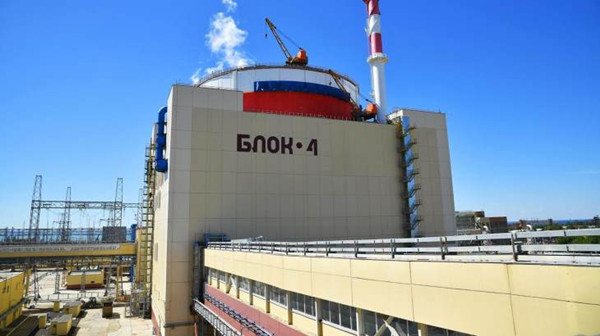Rostov unit 4 enters commercial operation
Unit 4 of the Rostov nuclear power plant in Russia has entered commercial operation three months ahead of schedule, state nuclear corporation Rosatom has announced.

Rostov unit 4 (Image: Rosatom)
Preparations for the physical start-up of Rostov 4 began on 6 December 2017, with the loading of nuclear fuel into the reactor. Within five days, all 163 fuel assemblies were installed and on 29 December the unit was put at the minimum controlled power level.
Rosatom announced on 23 January that Russian regulator Rostechnadzor had issued a permit required for start-up operations at the unit. The reactor began pilot operation on 21 January and was connected to the electricity grid on 1 February. The reactor reached 100% capacity on 14 April. According to Rosatom, Rostov 4 has already generated more than 3750 million kWh of electricity.
Rostechnadzor carried out a comprehensive inspection of the unit between 24 July and 3 August. On 25 September, Viktor Katkov, head of Rostechnadzor's Don regional office, signed the Statement of Conformity confirming that Rostov 4 meets the requirements of technical regulations and project documentation. A form stating that the unit is fully completed and ready for operation was signed the day before. These were the last documents required to confirm the completion of Rostov 4 and its readiness for commercial operation.
The 1000 MWe VVER pressurised water reactor was declared to have been put into commercial operation on 28 September - Russia's Nuclear Workers' Day. The corresponding order was signed by Andrey Petrov, general director of Rosenergoatom, Rosatom's nuclear power plant operating subsidiary, on the basis of permission for commercial operation granted by Rosatom.
Rosenergoatom said: "It should be noted that the Rostov nuclear power plant is the first plant in modern history, where the so-called line construction has been revived; it ensures both compliance with the project construction period and the most effective use of material and financial resources. Thanks to this, the construction of Rostov unit 4 was completed on time and with a saving of RUB1.56 billion (USD23 million)."
Rosatom said the unit will contribute RUB1 billion a year to the federal budget, and in its first year of commercial operation about RUB1.7 billion in property tax.
Four 1000 MWe VVER pressurised water reactors have been planned at the Rostov site, near the city of Volgodonsk, since the early 1980s. Construction of units 1 and 2 began promptly, but progress faltered. Units 1 and 2 eventually entered commercial operation in 2001 and 2010, respectively. Unit 3 was connected to the grid in 2015.
Russia's ten nuclear power plants have a total installed capacity of 27.9 GWe and Rostov 4 is the 36th reactor to be in operation in the country.
- China Institute of Atomic Energy
- Nuclear Power Institute of China
- Southwestern Institute of Physics
- China Nuclear Power Operation Technology Corporation, Ltd.
- China Nuclear Power Engineering Co., Ltd.
- China Institute for Radiation Protection
- Beijing Research Institute of Uranium Geology (BRIUG)
- China Institute of Nuclear Industry Strategy (CINIS)
- China Nuclear Mining Science and Technology Corporation


